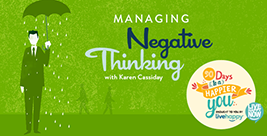As part of Live Happy’s special series 90 Days to a Happier You, we’ve gathered experts from around the country with unbeatable advice about how we can change habits and live better in 2016. Below, in the first of a series of blogs, anxiety expert Karen Cassiday, Ph.D., walks us through the steps of how to win the war against worry.
At some point, most of us have felt that surge of panic when a worry invades our mind. Worry is the anxious response to uncertainty; it narrows the field of infinite possibilities down to a few worst-case scenarios. For example, a worrier has a headache that won’t go away and thinks, “What if I have a tumor?” The worrier looks up all the symptoms of brain cancer and asks several friends about the headaches. A non-worrier, on the other hand, might just take an aspirin and assume nothing serious is wrong.
 Worriers constantly seek reassurance (WebMD anyone?). The irony is that this kind of inquiry makes worry much worse because it is a form of negative reinforcement—an attempt at a quick escape from worry and often an entry into a rabbit hole of increased worry. Worriers forget to do things that promote wellness. They spend their days in constantly trying to prevent bad things from happening instead of enjoying the present.
Worriers constantly seek reassurance (WebMD anyone?). The irony is that this kind of inquiry makes worry much worse because it is a form of negative reinforcement—an attempt at a quick escape from worry and often an entry into a rabbit hole of increased worry. Worriers forget to do things that promote wellness. They spend their days in constantly trying to prevent bad things from happening instead of enjoying the present.
The six steps:
Follow these six steps to help you address irrational thoughts, beliefs and behaviors that keep you in a cycle of worry.
1. Download the app, get the books, and look around the website
Start by downloading the free app “Self-help Anxiety Management–University of West England” (“SAM”), as we will do much of our work using the various tools on this app. Start by getting familiar with the tools and information available on the app and begin tracking your anxiety in the "How's my anxiety right now" section."
Meanwhile, start reading the book Women Who Worry Too Much or The Worry Cure; these books will fortify the six steps and give you more information for keeping worry at bay. You will also find excellent resources on the website for the Anxiety and Depression Association of America (full disclosure: I am the incoming president of this organization).
2. Keep a daily anxiety diary and do worry exposure
Use the app to begin worry exposure in the section titled “Mystical Monitor.” Record yourself talking about your worst worries and then play the recording repeatedly until your anxiety level decreases by about half. This may take 20 to 30 minutes of repeated listening. Do this worry exposure listening daily for at least 20 minutes, or until your worries no longer make you anxious. (This may take several days to several weeks until you become immune to your worst worries.)
3. Stop seeking reassurance
This is a tough one, because in the worrier's mind, his or her attempt to seek reassurance is a way to stop or postpone an imagined catastrophic future. It may take some time, but make it a daily goal to slow down and eventually stop seeking reassurance about your worries. Don't seek advice and reassurance from friends in the form of conversation or internet searches. This habit may take up to several months to break.
4. Challenge your thinking
Use the app section called “Thinking and Anxiety” to challenge the way you think when you worry. For example, you may not realize that you have traits of a perfectionist (many worriers do). Perfectionism increases worry by making you believe that there is only one narrow option for success instead of many flexible solutions. Your goal would be to finish the day with at least two to three mistakes and to discover that nothing terrible happened even when others noticed.
5. Decrease intolerance of uncertainty
 You can start to decrease procrastination and intolerance of uncertainty by doing daily uncertainty exposure practice. Look for uncertain situations that trigger your worry and then expose yourself to these situations without engaging in reassurance seeking, procrastinating or over-planning. Keep a list of your successes.
You can start to decrease procrastination and intolerance of uncertainty by doing daily uncertainty exposure practice. Look for uncertain situations that trigger your worry and then expose yourself to these situations without engaging in reassurance seeking, procrastinating or over-planning. Keep a list of your successes.
For example, your boss says very little when you talk about your work, and you begin to worry about being fired. Exposure practice would consist of talking to no one about the boss or the quality of your work and just going about your job.
6. Improve self-care
Read the “Health and Anxiety” section of the app. Make a list of things that you can do each day that promote your well-being and start doing them. Keep track of your successes in a daily journal.
One important form of self-care critical for people who worry is relaxation and meditation. Use the “Relaxation physical” and “Relaxation mental” portions of your app or any meditation or relaxation technique you like. Try practicing daily for about 15 to 20 minutes, or whatever amount of time fits your schedule.
Read Karen's second blog here, and her final blog here.
To see Karen's recommendations in action, read coaching "subject" Kim Baker's blog "No Worries."
Listen to Karen discuss how to Manage Negative Thinking on our podcast, Live Happy Now.
Karen Cassiday, Ph.D., is president of the Anxiety and Depression Association of America and a leading expert on the treatment of anxiety.















